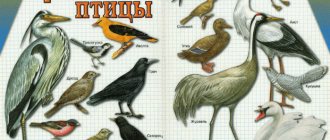Kinds
— Advertising —
The genus Soroki includes three species:
Pica hudsonia - American magpie
An American magpie walks through the grass
Appearance: body length – up to 50 centimeters, wingspan – 90 centimeters. Externally identical to the Common Magpie.
Distribution: Found in the USA and Mexico.
— Advertising —
Features: feeds on rodents and cacti. The nest builds without a roof. The bird is semantically related to the Californian magpie and forms a single subgenus with it.
Pica nuttalli - California magpie
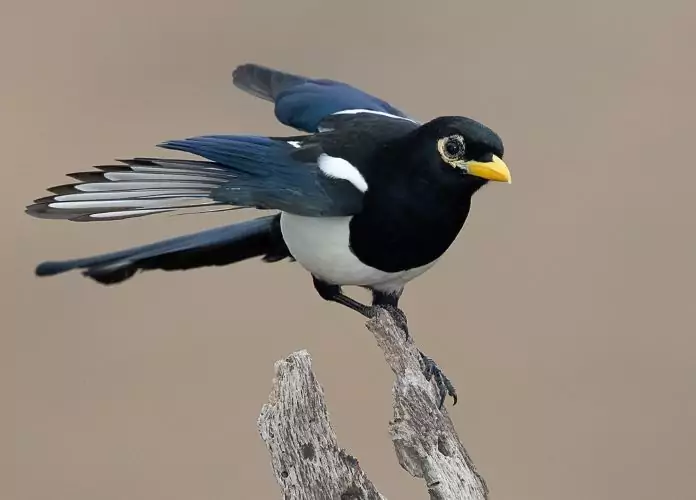
Appearance: black and white plumage, yellow beak and eye ring.
Distribution: The magpie lives in the California valley, hills and mountains.
Features: California magpie is susceptible to viral diseases. 15 years ago, West Nile virus killed half of the entire population.
Pica pica - common magpie or European magpie
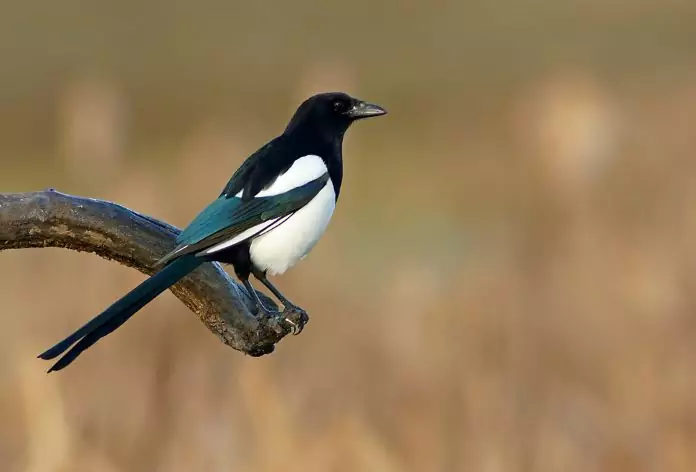
Appearance: a bird with traditional black and white plumage.
Distribution: the common magpie inhabits Europe and Russia, excluding the northeastern regions.
Features: the magpie is a typical representative of the bird family, inhabiting the cities and villages of Russia.
Varieties
There are 9 genera of magpies, and not all of them are genetically related. The closest relatives are crows and jays.
Blue (gray)
The bird is also known as Cyanopica cyana. Its main distribution area covers the Iberian Peninsula and the eastern part of Asia. The blue magpie has a medium-sized body (length - up to 36 cm), in this way it is similar to an ordinary one, but the beak and legs are shorter. The bird's belly is colored in various shades of brown, from beige to gray-brown. The back is always dark; on the wings the brown color harmoniously turns into blue. The throat is decorated with a white “tie”, the head is decorated with a cap of jet-black feathers with a metallic sheen.
Prefers open landscapes (pastures, meadows), but also inhabits evergreen forests and oak groves. However, due to high competition with other birds, it is sometimes forced to move closer to the border of its range, populating olive groves, parks, and gardens.
Lifestyle Features:
- Very social. Prefers to live in colonies of 3-8 pairs.
- It makes nests in trees using branches, moss, and dry leaves.
- It feeds on acorns, seeds, insects, invertebrates, and fruits. In times of famine - carrion.
Known as the "gray magpie".
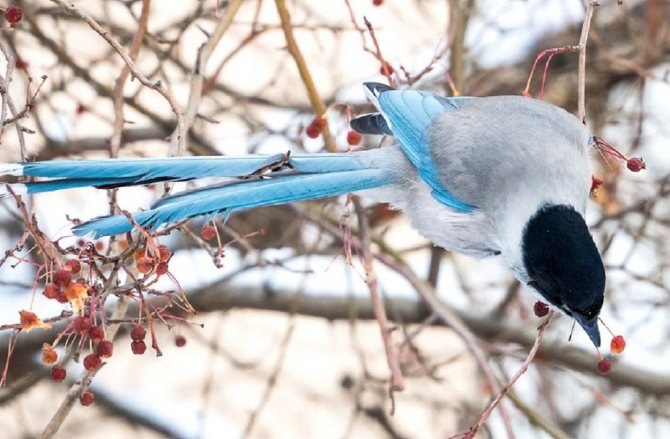
The gray or blue magpie is a beautiful bird that can be found in the forests of East Asia.
Green
Also called azure Chinese magpie or green cissus. A very beautiful bird, the color of which is dominated by rich light green tones.
The wings of the cissus are no less beautiful: deep red, the scarlet neck is decorated with a black rim running from the back of the head to the eyes.
Note! It is the cissa that has the longest tail in the magpie world.
Found in Thailand, India, Borneo and Sumatra.
Black, black and white
If the black and white magpie is the common magpie known to many, the most popular in Russia, then the black one is an exotic bird, and therefore very interesting.
It is found in Central Africa, preferring open palm forests. Body length is up to 40 cm, distinctive characteristic is black plumage. It feeds on insects, carrion, and small rodents.
Note! Representatives of the black variety do not hesitate to catch parasites on the skin of cattle.
Australian
The second name is Australian oystercatcher. It is found exclusively in Australia and Tasmania; some individuals are found in Indonesia.
Black body, pink legs, deep red beak - this is what the Australian magpie looks like. It is larger than other representatives of the species; an adult male weighs about 900 grams.
Blue-billed Thick-billed
It is found exclusively in Taiwan and is its symbol. Prefers mountainous areas, similar in appearance to ordinary ones. Birds live in small colonies and are omnivorous.
Picture 4 - The thick-billed Taiwanese azure magpie looks like a fabulous firebird, but residents of Russia can only admire it in the zoo.
Appearance
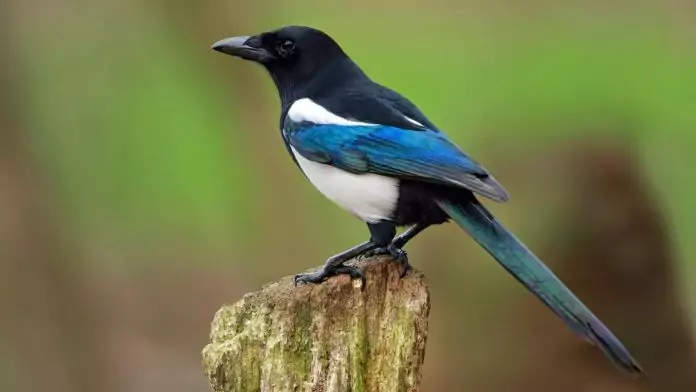
The magpie has a slender, elongated body; long fan-shaped tail; short, narrow, pointed at the end wings; small head and thick, curved beak. The paws are long, four-toed, the fourth toe points backward, which allows the bird to cling tightly to branches and maintain a stable position.
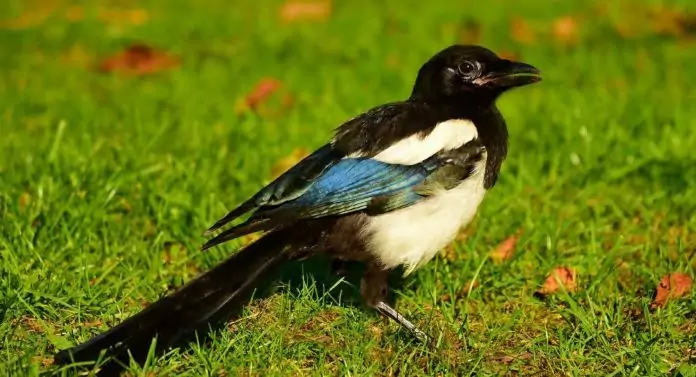
Magpie walks on green grass
The plumage of the magpie is two-colored: the head, neck, chest and back are blue-black. Violet and green shades are noticeable in the sun. The long tail is black. The belly and shoulders are white. Sometimes the wings along the border are also painted white. The eyes are black, the beak is dark gray, the legs are gray-brown.
The color of young birds also contains white and black, but the plumage is not as bright and contrasting as that of adult magpies. In spring, birds begin to molt. At this time, magpies look faded, some of the feathers fall out and patches of skin are visible here and there. By the beginning of summer, birds grow new dense matte feathers of rich, uniform color.
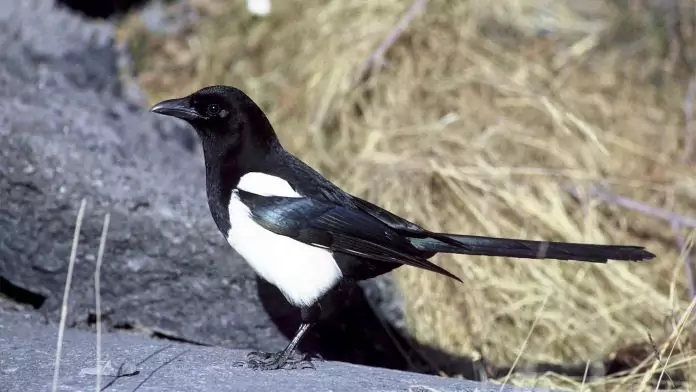
Photo of a magpie on a stone
The plumage of magpies of both sexes is identical, so it is almost impossible to distinguish a female magpie from a male. However, there are differences in size between birds: the male magpie is one and a half times larger than the female.
General description of the bird
The description of the magpie says that this group of birds belongs to the raven family along with 9 other genera.
Depending on how the light falls, a magpie's plumage may appear different. Such a bird shimmers with purple, blue and green tints, but after the spring molt these tones are lost. This can be especially noticeable in males. At the end of spring, such an overflow is difficult to notice.
The body size of the common magpie reaches almost 0.5 meters. The wingspan reaches up to 90 centimeters.
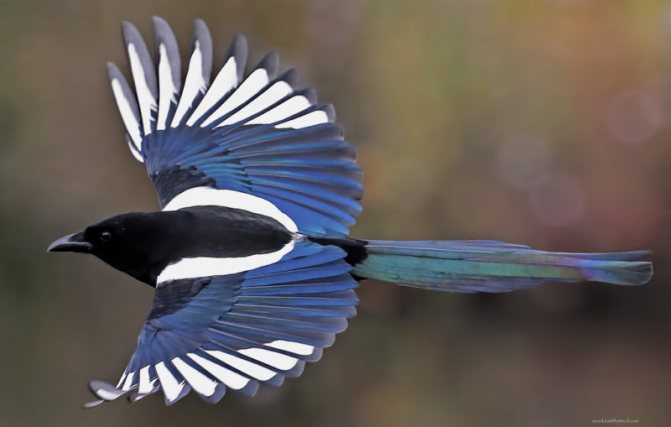
The magpie's tail is longer than the body itself and has a stepped shape.
The magpie's gait is special, although on the ground this bird moves in leaps and bounds. On the crown of trees, such birds move by jumping, and they do this quite quickly and dexterously. When a magpie flies in the air, you can notice that its flight is wavy.
What do magpies eat?
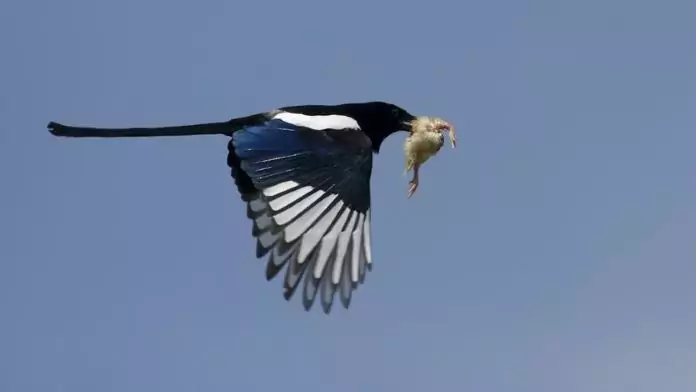
Magpies feed on food of animal origin. They are indiscriminate in their food and feed on all the small animals that come their way. In spring, magpies feed on caterpillars, worms, and beetle larvae; in summer - all kinds of insects; In winter, magpies feed on food waste. When there is a shortage of food, birds eat cereal seeds, bread crumbs, sunflower seeds, and the fruits of various trees. Adult magpies sometimes hunt small rodents and lizards. They kill their victims with a blow from their powerful beak.
Magpies are known predators of other people's nests. Where the magpie family lives, other small birds usually do not live, since the magpies simply eat them. In spring and early summer, magpies plunder the nests of passerines and waterfowl. They feast on the eggs and chicks of sparrows, ducks, coots, quails and partridges.
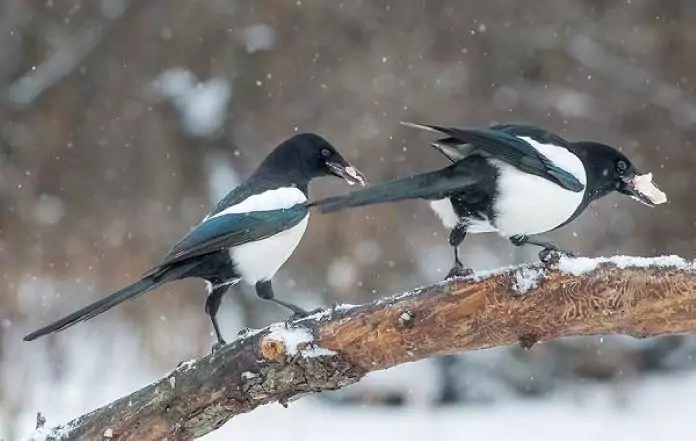
Two magpies are eating on a tree branch
Magpies cause a lot of trouble to rural residents. In search of food, birds fly to farmyards and attack chickens and ducklings. Magpies often steal chicken eggs. It is extremely difficult to catch magpies stealing, since these birds behave only in cases where they are not in danger. Magpies steal eggs from the chicken coop while the chickens are feeding. In a few minutes, forty manages to crack a chicken egg and drink it right “at the crime scene.” Many farmers ask the question: “what to do if a magpie steals eggs?” Birds can be scared away from the yard by a stuffed animal in the form of a person or all kinds of rattles and scarecrows (magpies are afraid of noise).
Magpie is a smart bird. When full, she will not throw away the remaining food, but will hide it in a secluded place. In case of hunger, she will remember her reserves. The bird never forgets about its hiding places; its intelligence allows it to quickly find hidden food.
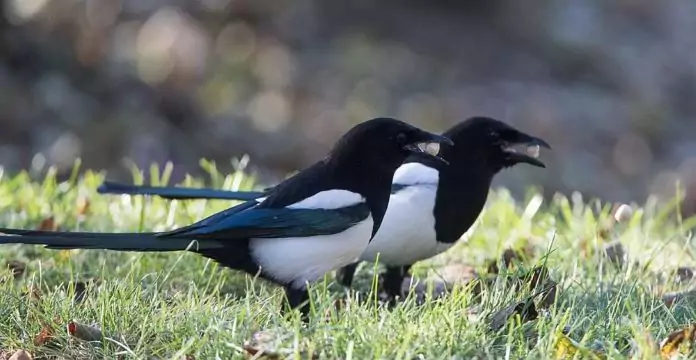
Magpies eat grains
At home, magpies eat leftover human food, chicken and beef, fish, vegetables and fruits. Magpie chicks feed on worm and beetle larvae, small caterpillars, flies and grasshoppers.
Why was the bird called magpie?
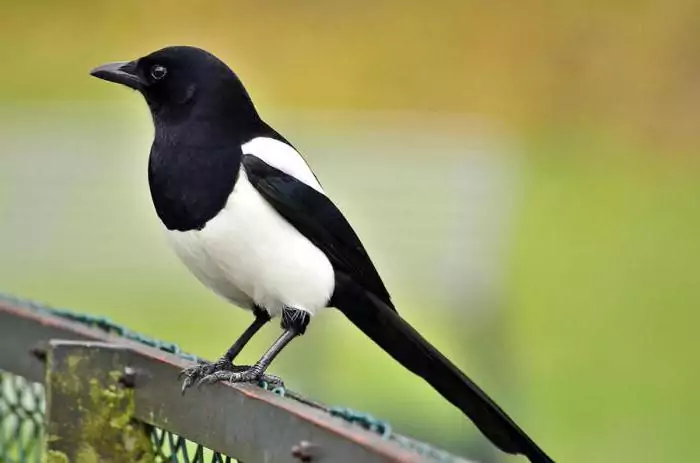
Magpie was named so for the sounds this bird makes. In the ancient Slavic dictionary, the word “welding” was used to define this bird, a derivative of “sverchati” - that is, “cricket” or “cricket”. As you know, the magpie makes a characteristic chirping sound - “chirping”.
Features of character and lifestyle
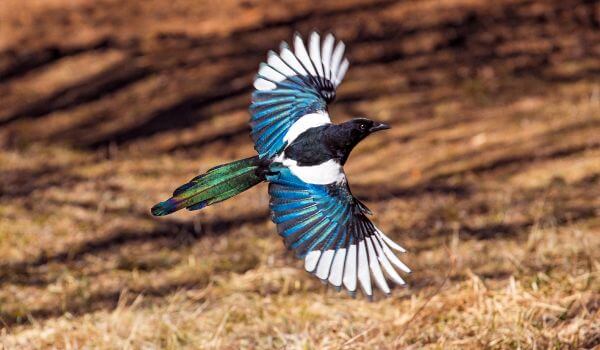
Photo: Magpie in flight
Magpies live in small flocks of 5-7 birds, less often alone. Group living is very beneficial for them from a safety point of view. The magpie warns of the approach of enemies or any suspicious living creatures by chirping, which other birds and even animals, such as bears, have learned to understand. That is why, when hunters appear, animals often run away only when they hear a magpie. The peculiarity of magpies is that they are paired, and form pairs for life.
Two birds always participate in the construction of nests. The nest is laid in a spherical shape with an entrance in the side and an adjacent clay tray. Clay and hard branches, along with leaves, are used to build walls and roofs, and branches are specially used for the roof. The insides of the nest are lined with straw, dry grass, roots and scraps of wool. During the breeding season, one pair can build several nests, but in the end they choose one. Abandoned nests are then inhabited by other birds, for example, owls, kestrels, and sometimes animals, for example, squirrels or martens.
Despite its sedentary lifestyle, compared to other corvids, the magpie is a very mobile and active bird. It is characterized by daily movements. She rarely stops for a long time in one place and constantly jumps from one branch to another, flies over long distances, searches bushes and trees in search of other people's nests and food. Leads a purely diurnal lifestyle.
The magpie has a good memory, and is also considered one of the most intelligent among all birds. Although she is very curious, she is also very cautious and able to avoid traps. The bird easily learns, masters new skills and quickly adapts to a changing environment. Zoologists have also discovered elaborate sequential actions and social rituals in magpies.
There are suggestions that magpies are even familiar with the expression of sadness. It is well known that these birds are partial to shiny objects, which they steal from people every now and then or pick up on the roads. It is interesting that thefts never occur openly, and before stealing an object, birds always first make sure that they are not in danger.
Interesting fact: today the magpie is the only bird that is able to recognize itself in the mirror, and not think that there is another individual in front of it.
Spreading
Area
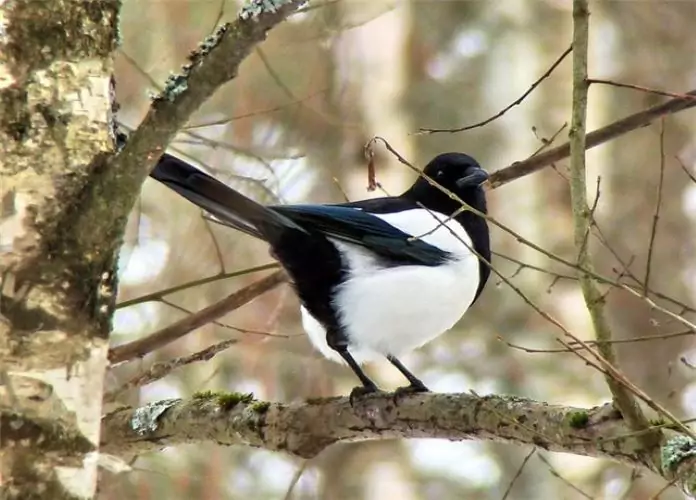
Magpies live in Eurasia, Africa, and North America. Most of the population is concentrated in Europe and Central Asia. Birds do not live in the north of the continent. Many magpie families live in Greece and the islands of the Mediterranean Sea. Magpies also inhabit some areas of North Africa - the coastal areas of Algeria, Tunisia, and Morocco. In America, these birds live in the western part - in California, Oregon and Alaska. In Canada, magpies are found in British Columbia.
Habitats
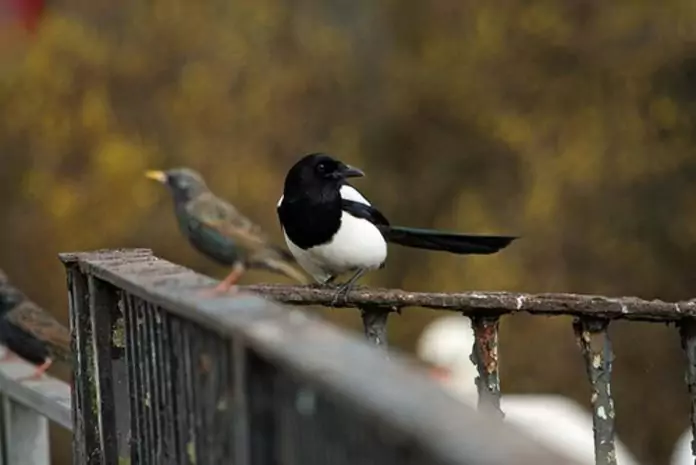
Magpies nest in open areas rich in small animals. Birds choose forest plantations or the outskirts of bush thickets to live. These birds are rare in large forests. Magpies settle near villages and cities, some inhabit city parks and squares. In winter, magpies live near human habitation, as this makes it easier to find food.
Behavior in nature
This is a very active, restless bird that can fly a considerable distance in search of food. Doesn't hesitate to destroy other people's nests. She avoids people because she is very careful. She is known for her amazing intellectual abilities: she can recognize her own reflection in the mirror and people’s faces.
Where does he live?
Magpies are often found in gardens and parks. They are widespread in Russia, Asia, Europe, northern Africa and North America. It prefers open spaces, but when threatened, it can hide in dense forest thickets.
Diet and food
They are omnivores and can eat both plant and animal food. Insects, small rodents, bird eggs, fruits, fruits, berries - this is what the magpie eats.
Beautiful birds can cause serious harm, destroying vegetable gardens and fields.
Features of hatching chicks
Birds often form strong pairs for life, build excellent nests, and both partners do this work. The magpie's nest is most often of impressive size and is equipped with a “roof” of dry twigs for protection from precipitation.
Note! The main material used for construction is grass and branches; the structure is coated with clay on top, making it very durable.
Egg laying begins at the end of April - the first days of May. The clutch includes 8 eggs, only the female does the incubation, the babies are born after 18 days.
The chicks stay with their parents for up to a month, feeding them insects and later small birds.
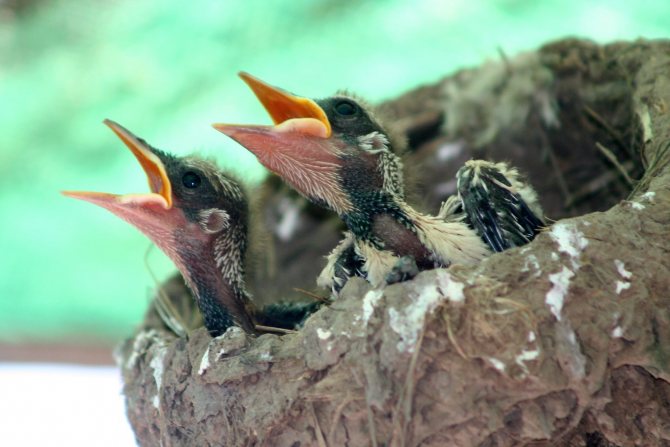
Looking at magpie chicks, it is difficult to imagine that in a couple of months they will turn into beautiful black and white birds.
Wintering or migratory
Many people are interested in whether the magpie is a wintering or migratory bird. This bird does not migrate, preferring to winter in its main habitat. However, those birds that live in northern latitudes can fly to warmer regions for the winter and return to their place in the spring.
Voice of the Magpie
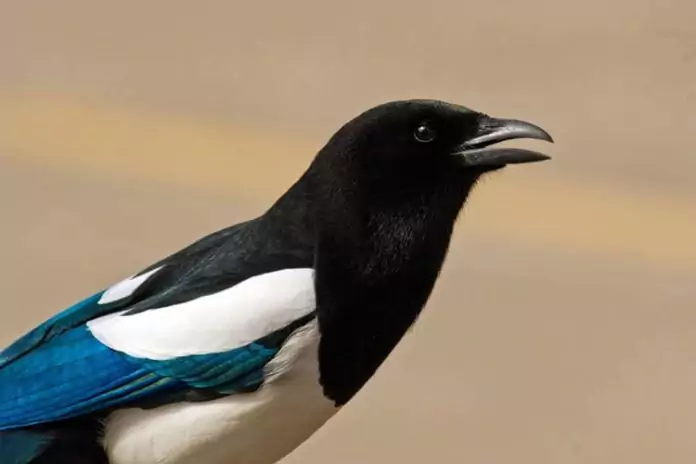
When communicating with each other, magpies use chirping sounds consisting of a series of syllables “chuck-kak-shak” or “shack-shack-shack”. The loud voice of a magpie is a warning signal. If the tempo of the chirping is fast and sharp, it means that danger is looming over the flock of birds. Hearing the warning cry, the birds fly away. A prolonged cry means that there may be a predatory animal nearby and the birds need to be on alert. The magpie's voice is ringing, hoarse and loud.
During the mating season, magpies use various intonations and sound forms in conversations with their fellows. So, for example, to indicate territory, the magpie calls “kia-kia” or “kick-kick.” Protecting the nest from uninvited guests, the magpie loudly shouts “chakr-chakr”, “chikr-chikr” or “chara-chara”.
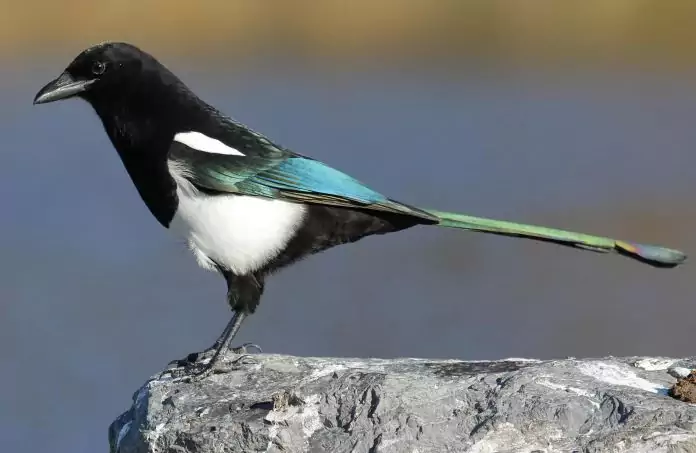
Magpie on the edge of a stone
To attract a partner, the bird makes quiet melodic sounds in different tones. Rhythmic singing can become arrhythmic, a low timbre is replaced by a high one, a soft trill alternates with abrupt menacing exclamations.
Chicks demanding food squeal in a shrill voice “pirr-pirr”. Young birds that have already separated from their parents are characterized by their own singing. When communicating with adult birds, they use two-syllable calls “yshiyak”, “chyuk” or “chew-yok”.
A story about forty children
Compared to other birds, the magpie stands out sharply with its bright white sides and very long tail.
The magpie is a popular character in folk tales and poems for children. Because of its white sides, it is called the white-sided magpie. As for the long tail, one of the legends says that the magpie got a long tail as a punishment for its talkativeness. The king of birds, the eagle, did not like the magpie’s long tongue, so he forced it to drag its long tail behind it. But this, of course, is a fairy-tale version of the origin of the magpie's tail. In fact, the magpie needs a long tail to balance its body, both during flight and when walking on the ground.
Magpies are quite large birds. The length of an adult individual can reach half a meter, and the wingspan is almost a meter. The plumage of magpies is bluish-black, with a metallic tint, and the sides are white. Magpies live in different countries and on different continents. They are also found in North America, Europe and even North Africa. And in our country this bird is found in many places.
Magpies are not particularly picky when choosing a place to live. They can settle in the forest, or they can look for a convenient place in the city, in close proximity to people. The character of these birds is quite scandalous and they behave very noisily. If magpies have settled in your yard, then, for sure, in the summer the whole house wakes up to their noisy chirping. For some reason, magpies are quiet in winter.
Another feature of magpies that people have noticed is a craving for bright objects. They drag various shiny little things into their nests and can even climb into a person’s home through an open window and cheekily rummage through things in search of objects of interest to them. Writers have repeatedly used this funny habit of magpies in their works, and the Italian composer Rossini wrote an opera called “The Thieving Magpie.”
Magpies make their nests in tall trees. Outwardly, these structures seem to be an absurd pile of branches of various sizes, but inside the nest everything is arranged quite conveniently - all the uneven spots between the branches are filled with earth and clay, and fluff and shreds of fur of various animals are laid on top. While hatching chicks, the magpies' character becomes quiet, the birds try not to attract attention to themselves. During this period, the female sits in the nest all day long, and the male gets food for her.
With the advent of chicks, magpies again become noisy and aggressive, attacking anyone who encroaches on their children. At such times, they can even attack a person approaching the nest. When the chicks grow up, they get out into the wild in a rather interesting way - they destroy the roof of the nest.
For some time, the magpie family wanders together around the surrounding area in search of food for the chicks. On the ground, magpies either walk or jump funny, like little children. But the chicks grow up enough that they begin to get their own food, after which they leave their parents and begin adult life.
Text author: Lev Poyasnikin
This entry is password protected. Enter your password to view comments.
Source
Magpie is a migratory or wintering bird
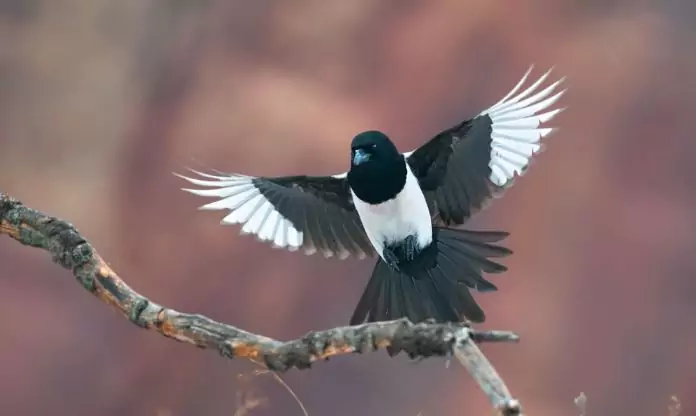
. Magpies are not migratory birds. They never fly away from the nesting site for a long time. In the autumn, wintering magpie birds gather in flocks and fly to the outskirts of cities and villages, as it is easier to find food there.
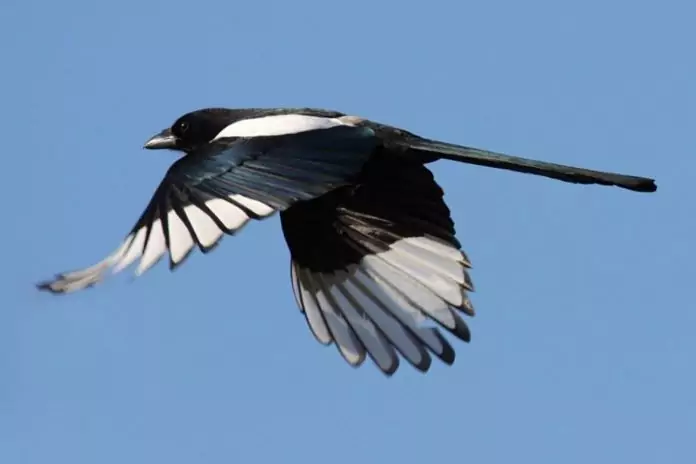
Magpie in flight
Despite the fact that magpies are sedentary birds, they still make periodic migrations within the perimeter of their habitat. As the sun sets, magpies living in the same area fly to a common roost. Magpies wait out the night in large flocks in windless, secluded bush thickets near water bodies. Neighboring birds gather for a mass roost in the same place during the autumn-winter period. Some of them fly to their “apartment” many kilometers from their permanent place of residence. Daily migrations stop in the spring, with the onset of the nesting period.
Appearance and features
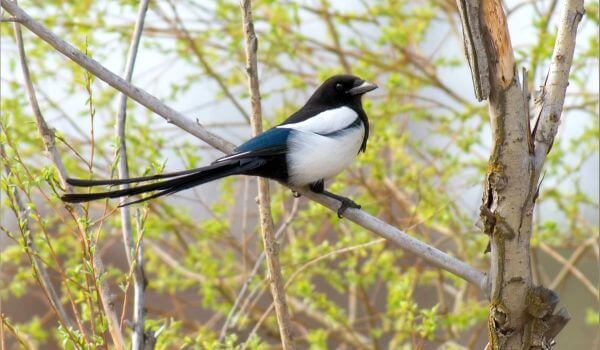
Photo: Magpie Bird
The color of the magpie is unique, and therefore it is well recognized by many. The entire plumage is black and white. The bird's head, neck, back and chest and tail are black with a metallic, sometimes bluish tint, tint and shine, especially evident in the sun's rays. At the same time, the belly, sides and shoulders of the magpie are white. Sometimes it happens that the tips of the wings are also painted white. Because of their characteristic white coloration, magpies are often called “white-sided magpies.”
Magpies can be up to 50 cm in length, but more often about 40-45 cm. The wingspan is 50-70 cm, in some cases up to 90 cm, but this is an exception rather than commonplace. The tail is quite long, almost 25 cm, which is almost half the length of the entire bird, stepped and quite mobile. Females and males do not differ in appearance, as they have the same color and the same size.
There is still a difference, and it consists in the fact that the males are slightly heavier, but this is not visually noticeable from the outside. The average male weighs about 230 grams, while the average female weighs approximately 200 grams. The bird's head is quite small, the beak is slightly curved and very strong, which is typical for all corvids.
The paws are of medium length, but very thin, four-toed. It moves along the ground in forty leaps and bounds, and simultaneously on both legs. The tail is held up. A gait like that of crows or pigeons is not typical for magpies. In flight, the bird prefers to glide, so the magpie's flight looks heavy and undulating. It is sometimes called "diving". During its flight, the magpie spreads its wings wide and spreads its tail, so it looks very beautiful, and its shape even resembles birds of paradise.
The loud chirping of a magpie is very characteristic. Its sound is very recognizable, and therefore it is difficult to confuse it with any other bird call.
Lifestyle
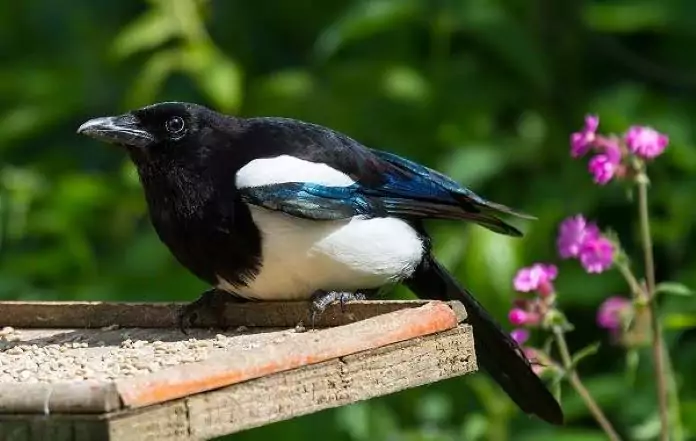
Magpies prefer to live separately from their relatives. Sometimes the birds gather in groups of 6-8 birds, but this does not last long - until the young animals mature up to a year and separate from the family. The rest of the time, magpies live in pairs. Bird nests are placed at a distance of 100-300 meters from each other. Such close proximity allows birds to promptly warn each other about danger.
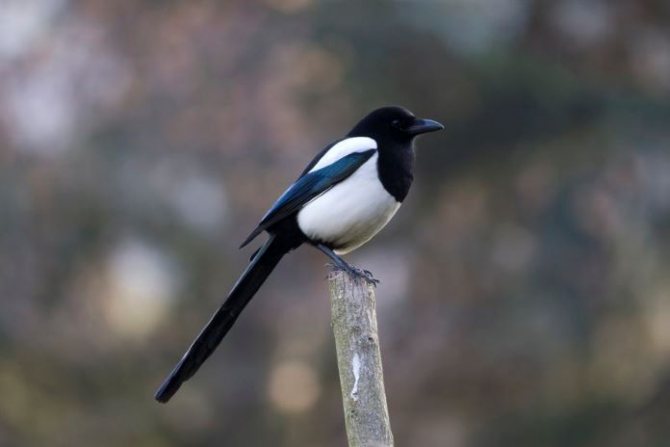
Lonely magpie on a branch
Magpies move across the surface not in steps, but in jumps. They jump on both legs at once. When moving, the bird's tail is raised up. The birds take off from their place. The flight of the magpie is smooth and maneuverable. During the flight, the bird opens its wings, straightens its tail, points its head forward, and bends its paws. In the air, the bird prefers to glide; its flight speed is 35-40 kilometers per hour.
It is known that magpies are cunning, dexterous and agile birds. If there is not enough food, then the birds look for food in vegetable gardens and farmyards.
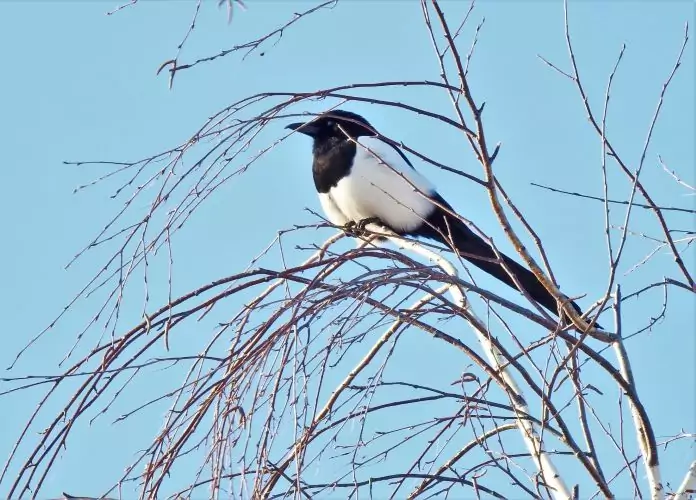
Photo of a magpie high on a tree
Birds can easily outwit a pet and steal something edible from its bowl. Sometimes birds forage for food in groups of 2-3 birds. While two magpies are distracting a chicken or a dog, the third one is feeding. Then the roles change.
Magpies are curious, but at the same time cautious, prudent birds. It has been noticed that these birds are able to build logical chains, remember information, and easily avoid traps. Birds do not openly steal: they first make sure that nothing threatens them, and only then they grab the thing or food they like and immediately fly away.
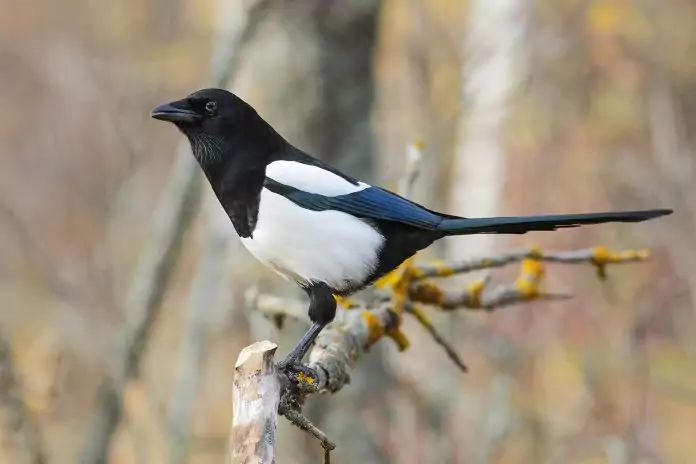
Pensive Magpie
Magpies are known for their passion for shiny things. These birds drag candy wrappers, sparkles, pebbles and glass sparkling in the sun into the nest. Ornithologists cannot say what motivates these birds in such collecting. But one thing is clear: the magpie’s ability to collect everything shiny formed the basis for the phrase “like a magpie,” that is, “a person who loves everything shiny - like a magpie.” True, experiments in recent years have made it possible to doubt that the magpie deliberately chooses only shiny objects. Researchers say that if a magpie is offered a choice of things, including one that is shiny, the bird will not always choose that one.
Reproduction
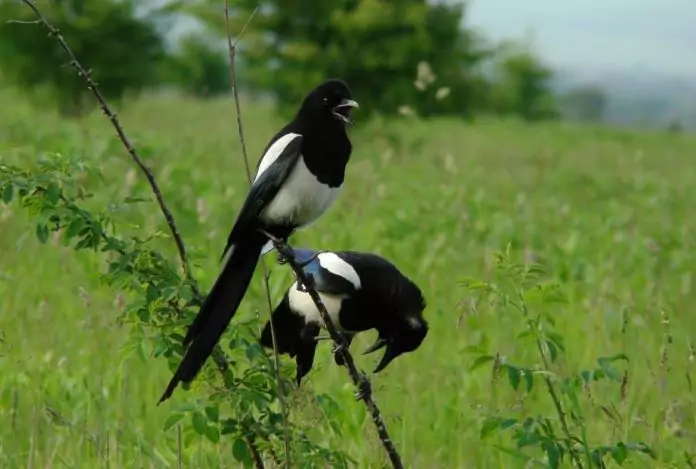
At the end of February, magpies begin their breeding season. Magpies gather at old nests and begin repairs. If the nest is severely destroyed, the magpies build a new one, but in a different place.
Nest
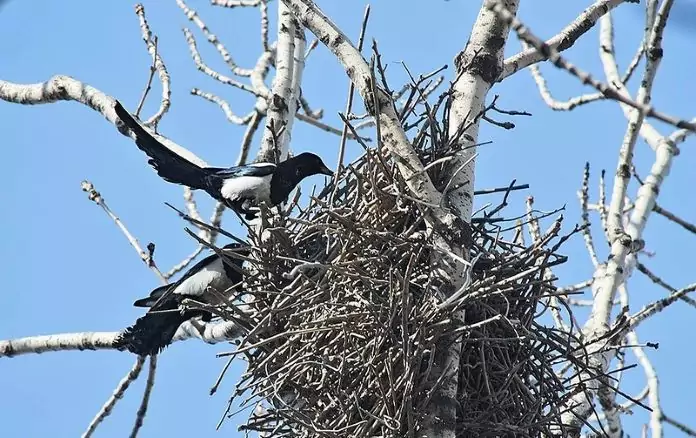
Magpies make nests on thin trees or bushes at a height of 3-6 meters on the ground. Despite the fact that the bird's nest seems accessible, predatory animals cannot reach it due to the fragile support on which the magpie's house rests.
A magpie's nest is a complex architectural structure. Unlike the nests of other birds, the magpie's has a roof. From a distance, the dwelling looks like a large ball assembled from dry branches. The frame of a magpie's nest is built from strong rods intertwined with each other. The roof of the bird is made from thin and flexible branches.
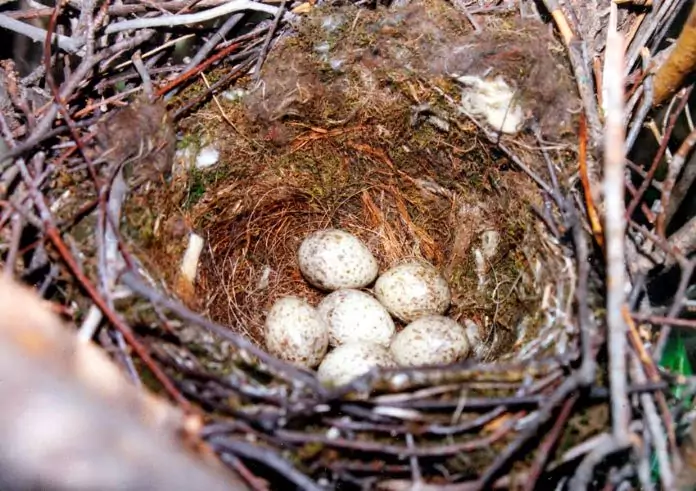
Photo of magpie eggs in a nest
The entrance is located in the side wall. The bottom of the bird's nest is smeared with clay or damp earth - such material will make the home even stronger. On top of the dried earthen floor there is a layer of leaves, thin young branches and roots. The female lays eggs on top of the woody layer.
Magpie chicks
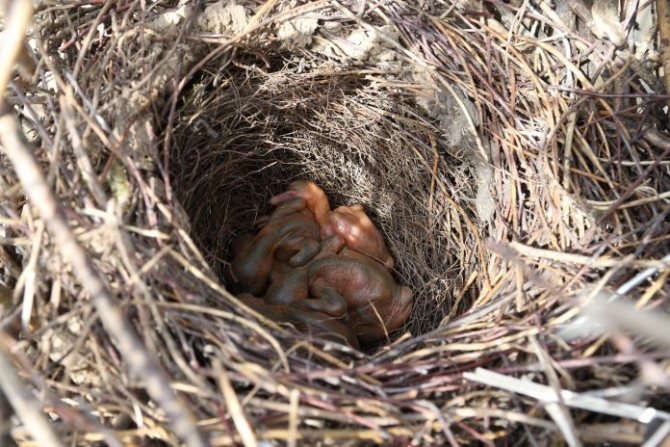
The female magpie lays 6-8 eggs. Magpie eggs look small, the shell is greenish with a brown spot. Incubation is done exclusively by the female. After 18-20 days, tiny naked chicks are born. Both parents are involved in heating and feeding the young. Adult birds take turns bringing worms and caterpillars to the hungry chicks. In the first days of life, the cubs have an increased appetite, so the chicks constantly demand food, squealing around the area. By the age of one month, the chicks have grown enough to look for food on their own. At this time, the magpies already master the technique of flight, but continue to stay close to their parents for at least another two months. By the following spring, the young birds separate from their parents and start a family.
Nesting Features
Magpies like to live in pairs. At the same time, they are devoted to their partner throughout their lives. They are also distinguished by their ability to build nests. Both the female and the male participate equally in the construction process. Where magpies winter and their nests was discussed above.
The magpie's nest, a photo of which is presented on the Internet, has a special design and is a unique structure in the world of birds. The nest is usually large, but is equipped with a so-called “roof”. This is a kind of prickly protection over the magpie’s home. A nest for future offspring is built from dry branches, and the top is coated with mud and clay. The nest tray is constructed from roots, grass, leaves and animal hair. The work of magpies during the construction of a home is really labor-intensive, and this despite the fact that these birds build several nests at once, and then choose the one in which to live as comfortably as possible. These birds place their nests very high, in the crown of trees or on bushes.

If the food supply in the magpie’s habitat is poor, then it decides to destroy someone else’s nest. But, if there is enough food for the chicks, then these birds do not go for robbery.
Magpie at home
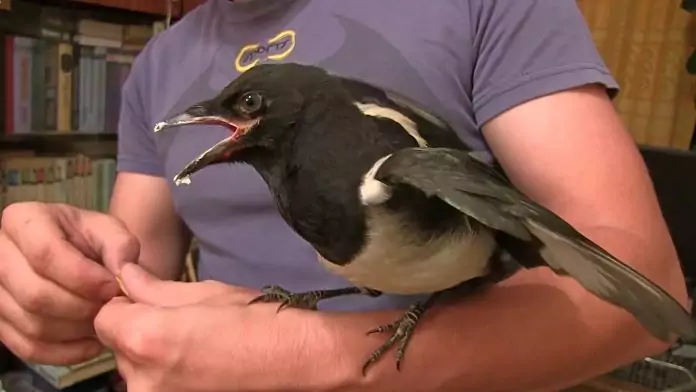
A wild bird like a magpie can become a pet. These birds quickly get used to humans and adapt to the surrounding conditions. Fed by humans, adult magpies recognize their owner by sight, become tame, feed from hands and do not fly away from him for long.
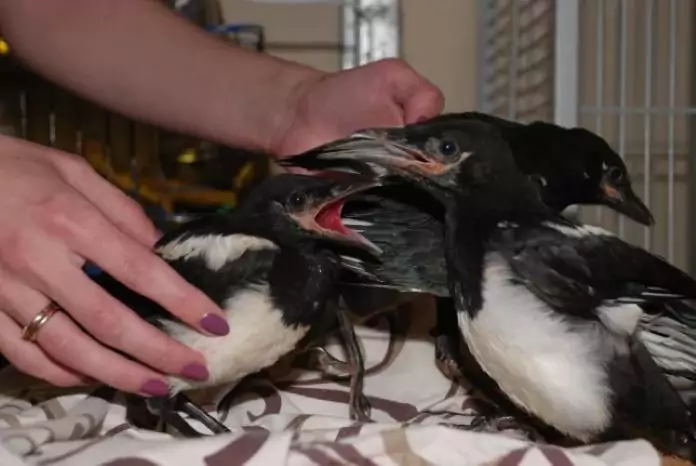
Magpie chicks at home
You can only tame a magpie that fell into human hands as a chick. Magpie cubs are easy to feed, as these birds are omnivores. Homemade food is suitable as food - fish and meat, bread, fruits and vegetables, berries and nuts. In order not to harm the fragile body, it is better to give food raw, without using any spices. Two-week-old chicks eat up to ten times a day, menstruation - three to four times. You need to feed the magpie in small pieces. Sometimes you can give cottage cheese and eggs. It is strictly forbidden to give poultry pork and white bread. Poultry needs vitamins, especially in the autumn-winter period.

An impudent magpie tries to steal food from a child
Magpies love to take a bath - by bathing, the birds cleanse their feathers and skin of parasites. This must be remembered when arranging an enclosure or cage for your pet. By the way, many magpie keepers do not limit the life of birds to a cage and allow their pets to move freely around the house. However, according to the observations of zoologists, the bird feels more comfortable in a cage and behaves calmer than when it lives in an open space.
Natural enemies of magpies
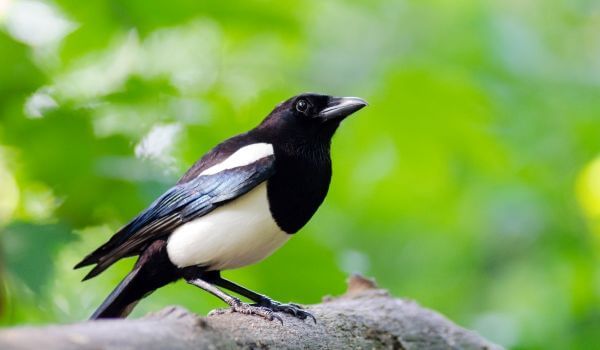
Photo: Magpie in nature
In the wild, forty's enemies include mainly large species of birds of prey:
- Falcons;
- Owls;
- Eagle owls;
- Eagles;
- Eagles;
- Hawks;
- Eagle owls.
Magpie chicks living in tropical regions also sometimes suffer from snake attacks. In our latitudes, a squirrel, hazel dormouse or marten can climb into a bird’s nest. Moreover, if the last two animals eat chicks and eggs, then the squirrel may not even feast on the bird’s eggs or its chicks, but simply throw them out of the nest.
And this also leads to their death. Adult birds are too large for such animals. But among larger mammals, adult magpies are often attacked by wild cats. Sometimes birds become prey for foxes and in very rare cases for wolves or bears. The magpie is very cautious, and therefore is caught very rarely, and the victims are mainly sick or very old birds.
Today, man has turned from an enemy of the magpie into something neutral. Yes, sometimes nests are destroyed or magpies are exterminated as pests, but this occurs in very rare cases, and magpies are saved by ingenuity and caution. At the same time, thanks to humans, birds have the opportunity to constantly find food in landfills.
Interesting Facts
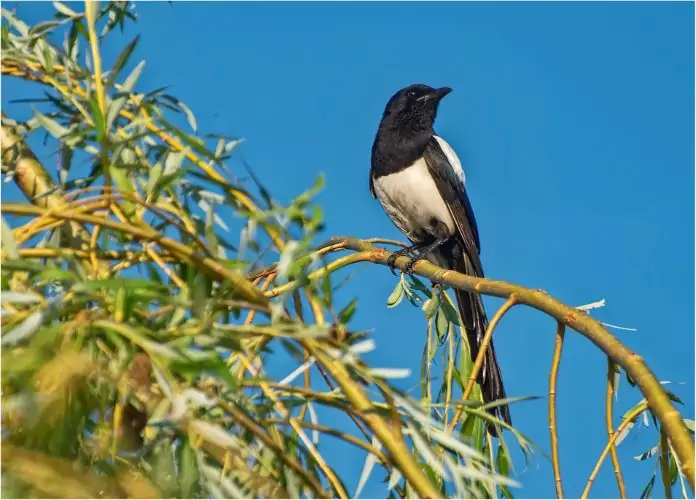
Photo of a magpie looking into the distance
- Magpie - able to recognize herself in the mirror.
- The entrance to the magpie's nest faces south to keep the home warmer.
- The magpie builds up to 8 nests, and then chooses the best one from them.
- Extra nests are needed to distract predators.
- In the Middle Ages, church ministers believed that magpies personified evil spirits. In the 14th century, Metropolitan Alexei even forbade birds from flying into the city for this reason.
- In China, the magpie is revered and considered the bird of happiness.
- In Rus' it was customary to call talkative women magpies.
Origin of the species and description
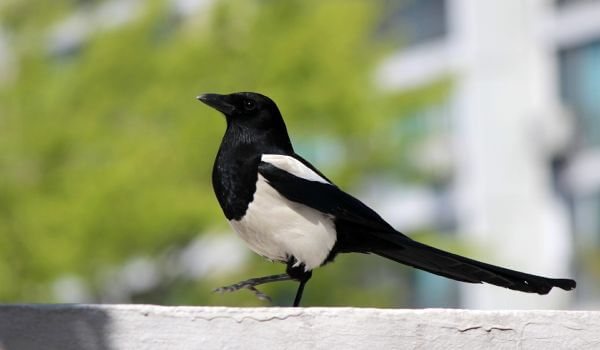
Photo: Soroka
The magpie, also known as the common magpie or, as it is sometimes called the European magpie, is a fairly well-known bird from the corvid family of the passerine order. With its name, it also gave the name to the genus of magpies, which also includes some exotic species that are similar to ordinary magpies in body structure, but differ from them in bright and variegated colors. The Latin name of the species is Pica pica. The closest relatives of these birds are crows and jays.
The time of origin of magpies and their separation from other corvids is not known for certain. The earliest fossil records of corvid-like birds date back to the Middle Miocene and are about 17 million years old. They were discovered on the territory of modern France and Germany. From this we can assume that the division of the family into species occurred much later.
Video: Magpie
Now ornithologists proceed from the assumption that magpies as a species appeared in Europe, and gradually spread across Eurasia, and then in the late Pleistocene they entered the territory of modern North America through the Bering Strait. However, fossils were found in Texas that were more reminiscent of the modern European magpie than the Californian subspecies, so there was a version that the common magpie could have appeared as a species already in the Pliocene, that is, about 2-5 million years ago, but in any case not earlier this time.
Today, at least 10 subspecies of magpie are known. Distinctive features of common magpies are their long tail and black and white coloration.
What are male magpies called?
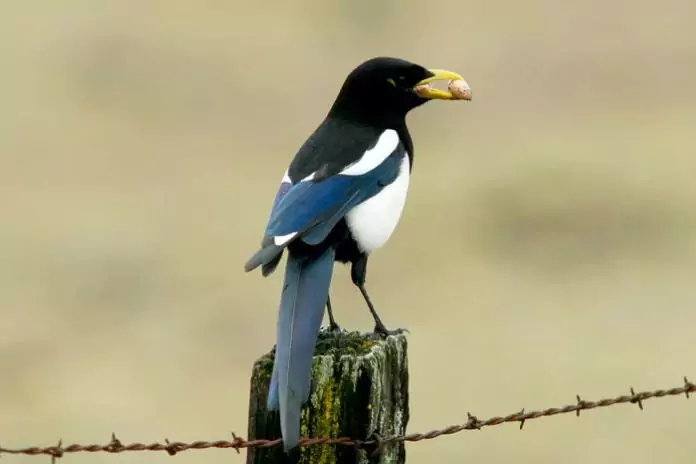
Like most wild birds, the “magpie” has a single name without distinguishing between female and male. Therefore, to indicate gender in Russian, the phrases “female magpie” and “male magpie” are used.
The magpie chick is called “magpie”, and in the plural – “magpie”.
Magpies are capable of onomatopoeia
The magpie's voice is sharp and sonorous. Their call is in the form of a loud chirping sound. At the same time, chirping, various third-party sounds and even screeching are woven into the song.
Magpies that are raised by humans are distinguished by their importunity and gullibility. Such a smart bird is quite sociable. Scientists described a case in which a large macaw parrot could not begin to speak for several months until its cage was placed next to the cage of a tame magpie, which did not stop talking day after day. At first, the macaw began to imitate the chattering magpie, and then he uttered individual words, while learning new ones and calling his own master’s children by names.
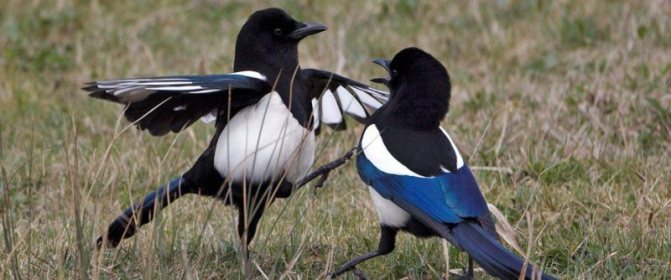
Signs associated with magpies
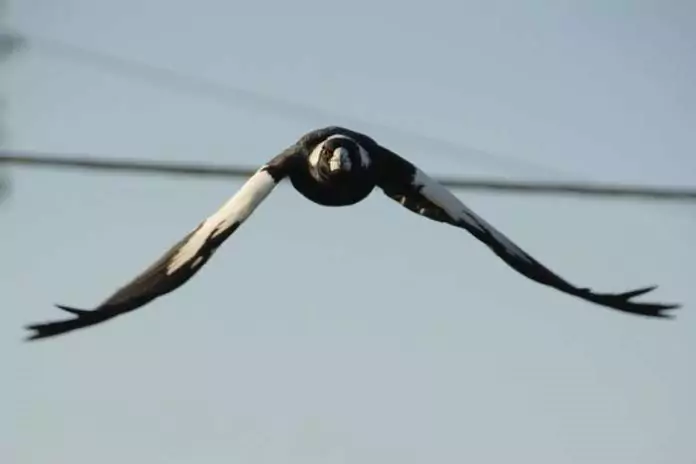
The image of a magpie is found in the cultures of many nations. For some, this bird represents happiness, wealth and success, for others it is a harbinger of bad news and trouble.
The magpie gained notoriety back in the days of Noah's Ark, when the bird did not fly onto the ship with all the other animals, but remained on the roof. The bird showed a complex character, not obeying other people's rules. The magpie is credited with negative qualities - a thief, a liar, a chatterbox. Many sayings are associated with this black and white bird.
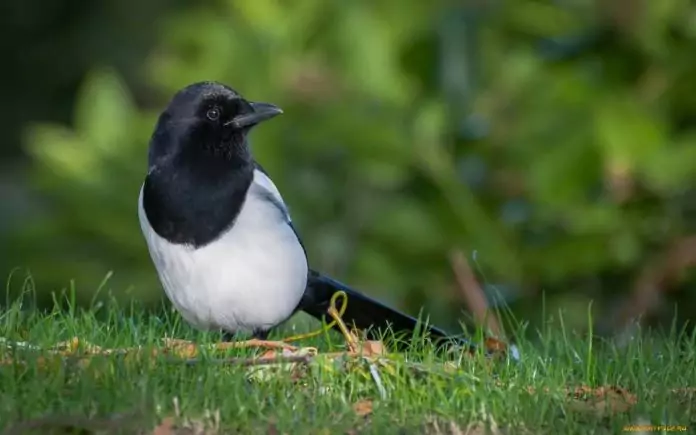
Beautiful magpie among green grass
This is how gossipers are called “cracking like a magpie,” and when talking about where a person learned about some news, they say “a magpie brought it on its tail.”
Despite the numerous unpleasant characteristics, most of the signs associated with the appearance of these birds still have a positive context.
- A bird flew onto the balcony - a sign that does not bode well. The house will be calm, no scandals or quarrels.
- A magpie flew into the house and chirped - good news awaits the family.
- A magpie flew into the yard or settled in the garden - the owners will face financial difficulties.
- A magpie circling over the house is a sign that signifies the onset of a dark streak in life.
- A magpie sat on the window, it jumps and chirps - a person will find himself in the center of gossip and intrigue.
- Two magpies are sitting in front of the house - guests should be expected.
- A flock of magpies flying overhead foreshadows a wedding.
- It is a bad omen if a bird knocks on the window - it brought bad news, perhaps one of the relatives will die soon.
- The magpie knocked on the window and flew away - a sign promising that all adversity will bypass the house.
About the birds of Russia for primary schoolchildren. Magpie
The magpie is somewhat smaller in size than the crow. Its head, wings and tail are black, with a greenish tint, and its belly is white. The tail is long, stepped, and serves as a magpie's rudder and balance during sudden movements on the ground and in flight.
Magpies prefer forest edges, bushes in floodplains, groves, gardens, parks, and tree plantations along railroad tracks. They willingly settle in the neighborhood of humans, and where they are left undisturbed, they become unusually trusting and even intrusive.
At the end of February, before breeding, magpies behave noisily, chase each other, spread their tails like a fan, and dance. However, magpies do not fly very well, preferring to jump from place to place.
In March, magpies begin to build new nests or repair old ones. The nest of this bird is usually located in dense thickets at a height of 2-3 m from the ground. It is well hidden from prying eyes, made of large twigs on the outside and thinner twigs on the inside, intertwined with blades of grass and held together with clay. The tray is also cemented with clay and is a hard, deep bowl-bed for eggs, covered with moss, soft grass, and wool. The top and sides of the tray are covered with a layer of thorny twigs, which form a roof, giving the nest a spherical shape. The entrance to the nest is located on the side. This arrangement of the house protects the female sitting on the eggs, and subsequently the chicks, from the invasion of predators. Through the loose walls of the nest, the female can notice the danger in time. A false nest is built close to the real one, in which the male is located when the female sits on the eggs.
Magpies lay 7-8 green eggs dotted with brown spots. The parents carefully feed the chicks with insects, snails and worms. The attachment of parents to their cubs is extremely strong.
In autumn and especially in winter, magpies can often be found on the outskirts of cities and towns. They move gracefully along the ground in small steps, raising their tails and wagging their heads with each step. There are many figurative expressions about magpies that reflect one or another of its features. For example, the definition of “white-sided magpie” does not require explanation, but the epithet “thief” is associated with the fact that the magpie is partial to unfamiliar, especially shiny objects. There are known cases when magpies grabbed metal spoons, keys and other things and flew away with them to then hide them somewhere in a secluded place. It is also clear why they say “talkative like a magpie” or “jumps like a magpie.”
Magpies are unique providers of living space for other birds. Owls and small falcons (for example, falcon, kestrel) settle in empty nests of magpies, exterminating mouse-like rodents, as well as great tits and tree sparrows. By doing this, magpies indirectly contribute to the population of the area by useful birds.
Source
Read about magpie
Whoever the magpie sees, it chirps.
What's wrong is that it's right there.
If a bird notices a nest, it will peck at the eggs and eat the flightless chicks.
And the beast has a hard time with the magpie: the magpie does not allow it to hide from its enemies. Tells everyone where everyone is hiding. Shouts:
The beast is hiding from the magpie. And forty is not a step away from him. Where he goes, so goes she.
He is across the field - a magpie is chirping above him:
That's what she is, a magpie!
A black grouse walks around the clearing, taking care of the chickens.
And they are swarming around, looking for food. We haven’t learned to fly yet, we haven’t grown up yet.
Whoever is bigger will offend them.
The magpie thief saw his prey. She hides, jumps closer, closer.
Kwoh! - the grouse shouted. - The enemy is close!
The magpie looks and looks, but doesn’t see a single chicken. There is no one! No one to grab! No one to swallow!
She got angry: “H-how is this so! How come!"
Then a black grouse flew at her and drove her away.
The magpie flew away from the grouse and cleaned itself. And he looks again and listens.
Isn't anyone coming? Is there food somewhere? Is it possible to take something away from someone?
The bear barks. The bears don't listen to her. They are playing around. One hits the puddle with his paws - splashes fly. Mishka likes it.
Another climbed onto the viburnum, swinging as if on a swing.
The magpie is right there and shouts:
Immediately the bear fell silent.
And the bears were scared. They are stupid, but they understand: while the bear was growling and grumbling, there was no enemy. It was possible to indulge. If she fell silent, that means she had to hide.
The bear came out of the puddle, the bear came out of the Kalinka, and they galloped into the thicket, where it was denser, until the magpie got rid of them.
The she-wolf brought food to the wolf cubs. Everyone pulled food towards themselves. They grumble and growl.
And the magpie from above will shout:
The wolves scatter in all directions. But the she-wolf doesn’t hide from the magpie. A magpie chirps above her; The magpie doesn’t understand that the she-wolf isn’t hiding on purpose. He takes her away from the wolf cubs.
Meanwhile, the wolf cubs returned, ate the prey, and left nothing for the magpie.
The lynx crawls towards the partridges. But they peck, feed, and don’t notice anything.
A magpie flew to them. She wonders what these chickens are pecking.
Someone moved in the bushes. A magpie flew up to the tree and saw an animal sneaking up on the partridges.
“I see! I see you! Here he is!
The chickens heard and took wing. The lynx jumped, but didn’t grab anyone.
The dog senses a goat's trail and wants to find and catch the goats. And the magpie is right there, chirping: “Here he is!” Here he is!"
The wild goats heard the magpie - and off they went! The dog chased them but didn’t catch up.
And the magpie listens again, looks out to see if there is any food or prey somewhere?
Please rate the work
Rating: 4.6 / 5. Number of ratings: 43




